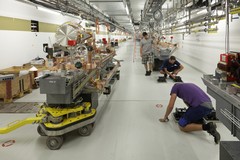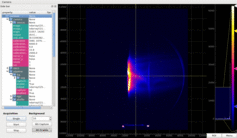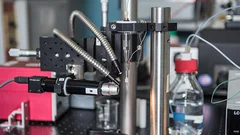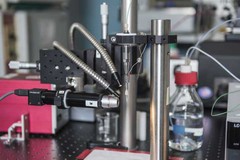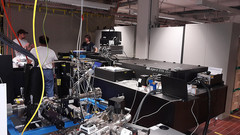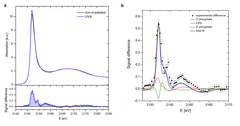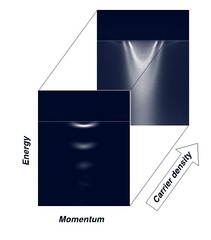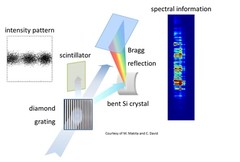News & Scientific Highlights
Completion of SwissFEL LINAC
On September 13th, the last two modules of the linear accelerator were installed in the SwissFEL tunnel. This means that 26 accelerating modules are installed now. One accelerating module consists of four accelerating structures. In total there are 104 accelerating structures, with a lenght of 2 m each.
SwissFEL First Free Electrons, First Beam at 144 MeV and First acceleration with SwissFEL C-band modules
For the first time electrons were accelerated with a SwissFEL C-band module (the first one of a series of 26 modules). The module operated with the nominal parameters that will be used in the last two linac sections. The RF pulse duration was 3 µs, at an RF power of 36 MW from the klystron. This pulse was compressed to 350 ns, yielding a peak power of approximately 215 MW. At these conditions, the energy gain was estimated to be 235 MeV, which is well within expectations.
First Free Electrons at SwissFEL
At SwissFEL the first free electrons were produced and accelerated to 7.9 MeV. The electrons were stopped directly after the gun in the gun-spectrometer. The bunch charge was 20-50pC, with a repition rate of 10Hz. First measurements showed that the generated electron beam was of high quality. This means that the first milestone for the SwissFEL beam commissioning was reached!
Surprendre les protéines en pleine action
Les protéines sont des composants indispensables à la vie. Elles jouent un rôle décisif dans de nombreux processus biologiques. Des chercheurs ont maintenant réussi à montrer comment étudier les processus ultrarapides au cours desquels les protéines effectuent leur travail, en utilisant un laser à rayons X à électrons libres comme le SwissFEL à l’Institut Paul Scherrer PSI. Les lasers à rayons X à électrons libres produisent des impulsions extrêmement brèves et intenses de lumière de type rayons X. Dans le monde, seules deux installations de ce type sont actuellement en service. Les résultats ont été publiés aujourd’hui dans la revue scientifique Nature Communications.
Catching proteins in the act
Some of the fastest processes in our body run their course in proteins activated by light. The protein rhodopsin sees to it that our eyes can rapidly take in their ever-changing surroundings. Free-electron X-ray lasers such as SwissFEL at the Paul Scherrer Institute PSI now make it possible for the first time to catch such processes in flagranti. Free-electron X-ray lasers generate extremely short and intense pulses of X-ray light.
First light from the SwissFEL Experimental Laser
The SwissFEL Experimental Laser 1 has successfully been delivered and installed in a temporary laser lab by Coherent, from where it will be moved to SwissFEL by end of 2016. The pre-installation in the temporary laser lab allows to become acquainted with the system, to set up a full monitoring and diagnostics system and to debug potential problems in the next months.
Investigating DNA Radiation Damage Using X-Ray Absorption Spectroscopy
The key to achieving more effective radioprotection and radiotherapy is to understand the exact mechanism of the interaction between radiation and biomolecules, and in particular to obtain the precise structure of the different forms of damage and their relative ratios. Among all biomolecules exposed to radiation, DNA plays an important role because any damage to its molecular structure can affect the whole cell and may lead to chromosomal rearrangements resulting in genomic instability or cell death.
Tailoring Novel Superconductivity
The band insulator strontium titanate SrTiO3 (STO), widely used as a substrate for growing oxide films, is a highly fascinating material. Recently, novel physical properties have been observed at the interface between STO and the materials grown on it. For instance the appearance of superconductivity above the temperature of liquid nitrogen, observed in a single monolayer of FeSe (its critical temperature is higher than in any iron-based bulk material) grown on the STO surface, suggests a key-role of the STO substrate.
Hard X-ray Photon Single-Shot Spectrometer of SwissFEL successfully delivered and installed
Not a joke: on 1st of April 2016 the Photon Single-Shot Spectrometer (PSSS) got delivered fully assembled and installed already to the front end of SwissFEL. It will measure the photon spectral information in every single shot for the Aramis beamline not only for the users, but also as a direct feedback to the machine during formation of the lasing process.
